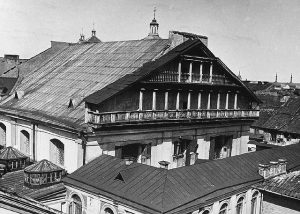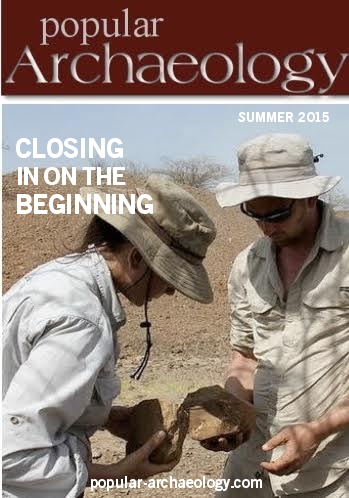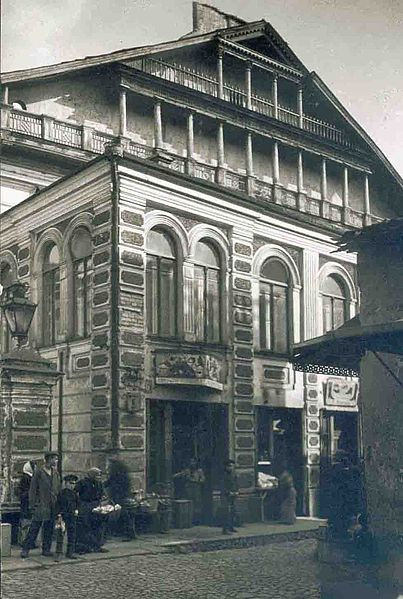
In 1944, the city of Vilna in Lithuania was under the grip of Nazi occupation. Like so many other Jewish communities throughout Europe at the time, citizens of Vilna became part of the Nazi “final solution” — the holocaust — including the destruction of their holy sites. Among the kosher meat stands, miqva’ot (ritual baths), and the famous Strashun rabbinical library, the most magnificent of these sites was the Great Synagogue and the Shulhof of Vilna. The synagogue was built in the 17th century in the Renaissance-Baroque style, and was burned to the ground in 1944 with the rest of the monuments to Jewish heritage in Vilna. In 1964, the Soviets demolished what was left and built a school over part of the foundation.
_________________________________________
The Great Synagogue of Vilna as it stood in 1934.
_______________________________________
Recently, however, archaeological efforts to locate the remains of the synagogue have led teams to use ground penetrating radar to identify its long-buried features. The results revealed surviving sections of the synagogue and possible remains of associated mikva’ot. They plan to initiate excavations next year. The research is a joint effort between the Israeli Antiquities Authority (IAA) and the Cultural Heritage Conservation Authority of Lithuania (CHCAL), with Jon Seligman (IAA), Zenonas Baubonis (CHCAL), and Richard Freund from the University of Hartford leading the project. The researchers hope to coordinate efforts of an international community of Jewish, Israeli and Lithuanian volunteers to expose the remains for study and public display, which will stand as a monument to the destruction of the entire Jewish community of Vilna.
The Israeli Antiquities Authority is encouraging sponsorship and participation in the project. Individuals interested in participating or supporting the efforts may do so by contacting the AIA.
______________________________________________
 Read more in-depth articles about archaeology with a premium subscription to Popular Archaeology Magazine.
Read more in-depth articles about archaeology with a premium subscription to Popular Archaeology Magazine.
In addition, the latest Popular Archaeology ebook is now available.
______________________________________________
Travel and learn with Far Horizons.
____________________________________________
 This richly illustrated ebook version of a recent Popular Archaeology issue includes the following stories: The discovery of the tomb of a previously unknown pharaoh that is shedding light on a lost ancient Egyptian dynasty; how genetics is revolutionizing what we know about human evolution and our prehistoric past; one scholar’s controversial ‘New Chronology’ and how it supports the historicity of the biblical Exodus; how archaeologists are unearthing new history in Williamsburg, Virginia, a seat of British colonial power in 18th century America; the discovery of the remains of a major Roman legionary base in Israel; the unearthing of an ancient Judean fortified settlement in the borderlands between the biblical kingdoms of ancient Judah and the Philistines; and how archaeologists are uncovering evidence of what may have been an important administrative center of Judah during the 8th century BCE. Now available from Amazon.com!
This richly illustrated ebook version of a recent Popular Archaeology issue includes the following stories: The discovery of the tomb of a previously unknown pharaoh that is shedding light on a lost ancient Egyptian dynasty; how genetics is revolutionizing what we know about human evolution and our prehistoric past; one scholar’s controversial ‘New Chronology’ and how it supports the historicity of the biblical Exodus; how archaeologists are unearthing new history in Williamsburg, Virginia, a seat of British colonial power in 18th century America; the discovery of the remains of a major Roman legionary base in Israel; the unearthing of an ancient Judean fortified settlement in the borderlands between the biblical kingdoms of ancient Judah and the Philistines; and how archaeologists are uncovering evidence of what may have been an important administrative center of Judah during the 8th century BCE. Now available from Amazon.com!
____________________________________________








